Physical-Mechanical Behavior of CDW and Tire Flake Integration in Building Block Manufacturing
Abstract
:1. Introduction
2. Materials and Methods
2.1. Stone Materials
- -
- Absorption humidity (ASTM C127-15 [37]);
- -
- Specific gravity or saturated relative density (ASTM C127-15 [37]);
- -
- Dry and loose volumetric mass (MVSS) (ASTM C29/C29M-07 [38]);
- -
- Compacted dry volumetric mass (MVSC) (ASTM C29/C29M-07 [38]);
- -
- Granulometry or particle size analysis (ASTM C 136/C 136M-19 [39]).
2.2. Cement
2.3. Water
2.4. Construction and Demolition Waste (CDW)
- -
- Absorption humidity (ASTM C127-15 [37]);
- -
- Specific gravity or saturated relative density (ASTM C127-15 [37]);
- -
- Dry and loose volumetric mass (MVSS) (ASTM C29/C29M-07 [38]);
- -
- Compacted dry volumetric mass (MVSC) (ASTM C29/C29M-07 [38]);
- -
- Granulometry or particle size analysis (ASTM C 136/C 136M-19 [39]).
2.5. Tire Flakes
2.6. Mix Design
2.7. Specimen Processing
- -
- Mixing: A motorized blade mixer was used for mixing (Figure 2a,b). The coarse aggregates (gravel and CDW) were added first, followed by fine aggregates (silt and tire flakes); then, the cement was added, and they were dry-mixed until a homogeneous mixture was achieved. Then, the water was incorporated in partial quantities until reaching the total for each mixture and achieving again a homogeneous mixture.
- -
- Filling of molds: Once the adequate consistency of the mixture was obtained, the gate was opened (Figure 2b), and the manufacture of the blocks continued. We placed the mixture inside the molds, and the specimens were manufactured through vibro-compacting (semi-industrial manual equipment of national elaboration, with a single-phase motor at 110 V with 2 HP, including a mold for a block of any model and size; model CK-7571) (Figure 3a–c).
- -
- Storage and curing of specimens: Finally, the specimens were left to dry for three days, outdoors, covered with plastic in order to not lose moisture too quickly. Subsequently, they were taken to cure in the wet sand beds of the materials laboratory “Luis Silva Ruelas” at the UMSNH.
2.8. Tests Performed on the Blocks
2.9. Microscopic Evaluation of Mortars
3. Results and Discussion
3.1. Characterization of Aggregates and CDW
3.2. Mechanical Tests on the Blocks
3.2.1. Compressive Strength
3.2.2. Flexural Strength
3.2.3. Static Module of Elasticity
3.3. Physical Tests in the Blocks
3.3.1. MEB Images
3.3.2. Absorption Humidity
3.3.3. Electrical Resistivity (ER)
3.3.4. Unit Cost Analysis of Specimen Manufacturing
4. Conclusions
Author Contributions
Funding
Institutional Review Board Statement
Informed Consent Statement
Data Availability Statement
Conflicts of Interest
References
- Arisha, A.; Gabr, A.; El-Badawy, S.; Shwally, S. Using Blends of Construction & Demolition Waste Materials and Recycled Clay Masonry Brick in Pavement. Procedia Eng. 2016, 143, 1317–1324. [Google Scholar] [CrossRef]
- Desai, M.; Yadav, N.; Desai, N. Application of Recycled Soil and Sand in Brick Production over Conventional Clay Brick: A Sustainable Alternative. Mater. Today Proc. 2023, 77, 879–886. [Google Scholar] [CrossRef]
- Singh, S.; Dalbehera, M.M.; Maiti, S.; Bisht, R.S.; Balam, N.B.; Panigrahi, S.K. Investigation of Agro-Forestry and Construction Demolition Wastes in Alkali-Activated Fly Ash Bricks as Sustainable Building Materials. Waste Manag. 2023, 159, 114–124. [Google Scholar] [CrossRef] [PubMed]
- Hawken, P.; Lovins, A.B.; Lovins, L.H. Natural Capitalism: The Next Industrial Revolution; Gabriel Thoumi Sustainability Collection; Earthscan: London, UK, 2010; ISBN 978-1-84407-170-8. [Google Scholar]
- Chandru, U.; Bahurudeen, A.; Senthilkumar, R. Systematic Comparison of Different Recycled Fine Aggregates from Construction and Demolition Wastes in OPC Concrete and PPC Concrete. J. Build. Eng. 2023, 75, 106768. [Google Scholar] [CrossRef]
- Jike, N.; Xu, C.; Yang, R.; Qi, Y.; Dai, Y.; Peng, Y.; Wang, J.; Zhang, M.; Zeng, Q. Pervious Concrete with Secondarily Recycled Low-Quality Brick-Concrete Demolition Residue: Engineering Performances, Multi-Scale/Phase Structure and Sustainability. J. Clean. Prod. 2022, 341, 130929. [Google Scholar] [CrossRef]
- Yang, D.; Liu, M.; Ma, Z. Properties of the Foam Concrete Containing Waste Brick Powder Derived from Construction and Demolition Waste. J. Build. Eng. 2020, 32, 101509. [Google Scholar] [CrossRef]
- Gu, F.; Xie, J.; Vuye, C.; Wu, Y.; Zhang, J. Synthesis of Geopolymer Using Alkaline Activation of Building-Related Construction and Demolition Wastes. J. Clean. Prod. 2023, 420, 138335. [Google Scholar] [CrossRef]
- Hu, K.; Chen, Y.; Naz, F.; Zeng, C.; Cao, S. Separation Studies of Concrete and Brick from Construction and Demolition Waste. Waste Manag. 2019, 85, 396–404. [Google Scholar] [CrossRef]
- Wichmann, I.; Stephan, D. Mechanical and Physical Properties of Concrete Made of Alkali-Activated Lightweight Aggregates from Construction Demolition Waste. Mater. Today Proc. 2023. [Google Scholar] [CrossRef]
- Chen, B.; Zheng, Y.; Zhao, Y.; Wang, Y.; Zhou, T. Recycled Brick Powder from Construction and Demolition Waste as Waterborne Coating Filler with Robust Scrubbing Resistance. Constr. Build. Mater. 2023, 385, 131494. [Google Scholar] [CrossRef]
- Sharma, A.; Shrivastava, N.; Lohar, J. Construction & Demolition Waste in Geotechnical Applications: A Review. Mater. Today Proc. 2023. [Google Scholar] [CrossRef]
- Dos Reis, G.S.; Cazacliu, B.G.; Cothenet, A.; Poullain, P.; Wilhelm, M.; Sampaio, C.H.; Lima, E.C.; Ambros, W.; Torrenti, J.-M. Fabrication, Microstructure, and Properties of Fired Clay Bricks Using Construction and Demolition Waste Sludge as the Main Additive. J. Clean. Prod. 2020, 258, 120733. [Google Scholar] [CrossRef]
- Ferriz-Papi, J.A.; Thomas, S. Recycled Aggregates from Construction and Demolition Waste in the Production of Concrete Blocks. J. Constr. Mater. 2020, 2, 1–6. [Google Scholar] [CrossRef]
- Zubair, M.; Humayun Mahmood, G.M.S.I. Geopolymer-Based Building Blocks Using Construction and Geopolymer-Based Building Blocks Using Construction. In Proceedings of the 6th International Conference on Advances in Civil Engineering (ICACE-2022), Virtual, 20–22 December 2022. [Google Scholar]
- Liu, D.; Qiao, L.; Li, G. Experimental Performance Measures of Recycled Insulation Concrete Blocks from Construction and Demolition Waste. J. Renew. Mater. 2022, 10, 1675–1691. [Google Scholar] [CrossRef]
- Rojas-Valencia, M.N.; Rivas-Torres, B.I.; Fernández-Rojas, D.Y.; Gómez-Soberón, J.M. Recovery of Mixtures of Construction Waste, PET and Sugarcane Bagasse for the Manufacture of Partition Blocks. Materials 2022, 15, 6836. [Google Scholar] [CrossRef] [PubMed]
- Quadratin. En 10 Años se Duplicó la Cantidad de Vehículos en Michoacán. Available online: https://www.quadratin.com.mx/principal/En-10-anos-se-duplico-la-cantidad-de-vehiculos-en-Michoacan/ (accessed on 8 August 2023).
- La voz de Michoacán. Sin Freno, Crecimiento Vehicular en Morelia; Hay 2 Automóviles por Cada 3 Habitantes. Available online: https://www.lavozdemichoacan.com.mx/michoacan/morelia-appmobil/sin-freno-crecimiento-vehicular-en-morelia-hay-2-automoviles-por-cada-3-habitantes/ (accessed on 8 August 2023).
- INEGI. Available online: https://www.inegi.org.mx/app/cuadroentidad/Mich/2022/22/22_6 (accessed on 8 August 2023).
- Fraile-Garcia, E.; Ferreiro-Cabello, J.; Defez, B.; Peris-Fajanes, G. Acoustic Behavior of Hollow Blocks and Bricks Made of Concrete Doped Withwaste-Tire Rubber. Materials 2016, 9, 962. [Google Scholar] [CrossRef] [PubMed]
- Gerges, N.N.; Issa, C.A.; Fawaz, S.A. Rubber Concrete: Mechanical and Dynamical Properties. Case Stud. Constr. Mater. 2018, 9, e00184. [Google Scholar] [CrossRef]
- Sambucci, M.; Valente, M. Ground Waste Tire Rubber as a Total Replacement of Natural Aggregates in Concrete Mixes: Application for Lightweight Paving Blocks. Materials 2021, 14, 7493. [Google Scholar] [CrossRef] [PubMed]
- Rocha, J.H.A.; Galarza, F.P.; Chileno, N.G.C.; Rosas, M.H.; Peñaranda, S.P.; Diaz, L.L.; Abasto, R.P. Compressive Strength Assessment of Soil–Cement Blocks Incorporated with Waste Tire Steel Fiber. Materials 2022, 15, 1777. [Google Scholar] [CrossRef]
- Tarek, D.; Ahmed, M.M.; Hussein, H.S.; Zeyad, A.M.; Al-Enizi, A.M.; Yousef, A.; Ragab, A. Building Envelope Optimization Using Geopolymer Bricks to Improve the Energy Efficiency of Residential Buildings in Hot Arid Regions. Case Stud. Constr. Mater. 2022, 17, e01657. [Google Scholar] [CrossRef]
- Gao, Q.; Xiao, J.; Shen, J.; Hou, Y.; Guo, J. Properties of Super-Thin Layer Mortar with Recycled Brick Fines for Sintered Perforated Block Masonry. Case Stud. Constr. Mater. 2023, 18, e02015. [Google Scholar] [CrossRef]
- Srividya, T.; Kannan Rajkumar, P.R. Mechanical and Durability Properties of Alkali-Activated Binders Based Paver Blocks Derived from Secondary Sources. Case Stud. Constr. Mater. 2022, 17, e01561. [Google Scholar] [CrossRef]
- Hussain, I.; Ali, B.; Rashid, M.U.; Amir, M.T.; Riaz, S.; Ali, A. Engineering Properties of Factory Manufactured Paving Blocks Utilizing Steel Slag as Cement Replacement. Case Stud. Constr. Mater. 2021, 15, e00755. [Google Scholar] [CrossRef]
- Mahdi, S.N.; Babu, R.D.V.; Hossiney, N.; Abdullah, M.M.A.B. Strength and Durability Properties of Geopolymer Paver Blocks Made with Fly Ash and Brick Kiln Rice Husk Ash. Case Stud. Constr. Mater. 2022, 16, e00800. [Google Scholar] [CrossRef]
- Djamaluddin, A.R.; Caronge, M.A.; Tjaronge, M.W.; Lando, A.T.; Irmawaty, R. Evaluation of Sustainable Concrete Paving Blocks Incorporating Processed Waste Tea Ash. Case Stud. Constr. Mater. 2020, 12, e00325. [Google Scholar] [CrossRef]
- Chaikaew, C.; Sukontasukkul, P.; Chaisakulkiet, U.; Sata, V.; Chindaprasirt, P. Properties of Concrete Pedestrian Blocks Containing Crumb Rubber from Recycle Waste Tyres Reinforced with Steel Fibres. Case Stud. Constr. Mater. 2019, 11, e00304. [Google Scholar] [CrossRef]
- Tayeh, B.A.; Akeed, M.H.; Qaidi, S.; Bakar, B.H.A. Ultra-High-Performance Concrete: Impacts of Steel Fibre Shape and Content on Flowability, Compressive Strength and Modulus of Rupture. Case Stud. Constr. Mater. 2022, 17, e01615. [Google Scholar] [CrossRef]
- Wang, X.; Chin, C.S.; Xia, J. Study on the Properties Variation of Recycled Concrete Paving Block Containing Multiple Waste Materials. Case Stud. Constr. Mater. 2023, 18, e01803. [Google Scholar] [CrossRef]
- Awoyera, P.O.; Olalusi, O.B.; Ibia, S.; Prakash, A.K. Water Absorption, Strength and Microscale Properties of Interlocking Concrete Blocks Made with Plastic Fibre and Ceramic Aggregates. Case Stud. Constr. Mater. 2021, 15, e00677. [Google Scholar] [CrossRef]
- Antoun, M.; Issa, C.A.; Aouad, G.; Gerges, N. Sustainable Masonry Blocks: Olive Wood Waste as Substitute for Fine Aggregates. Case Stud. Constr. Mater. 2021, 15, e00590. [Google Scholar] [CrossRef]
- Tayeh, B.A.; Akeed, M.H.; Qaidi, S.; Bakar, B.H.A. Influence of Sand Grain Size Distribution and Supplementary Cementitious Materials on the Compressive Strength of Ultrahigh-Performance Concrete. Case Stud. Constr. Mater. 2022, 17, e01495. [Google Scholar] [CrossRef]
- ASTM C127-15; Standard Test Method for Relative Density (Specific Gravity) and Absorption of Coarse Aggregate. ASTM International: West Conshohocken, PA, USA, 2015.
- ASTM C29/C29M-07; Standard Test Method for Bulk Density (“Unit Weight”) and Voids in Aggregate. ASTM International: West Conshohocken, PA, USA, 2007.
- ASTM C136/C136M-19; Standard Test Method for Sieve Analysis of Fine and Coarse Aggregates. ASTM International: West Conshohocken, PA, USA, 2019.
- Organismo Nacional de Normalización y Certificación de la Construcción y Edificación, S.C. (ONNCCE) NMX-C-414-ONNCCE-2017 Building Industry-Hydraulic Cements-Specifications and Testing Methods 2017. Available online: https://www.onncce.org.mx/es/venta-normas/fichas-tecnicas?view=item&id=1879 (accessed on 8 August 2023).
- Comisión Europea Service Contracton Management of Construction and Demolition waste-SR1. Reporte Final; Paris, 2011. Available online: https://op.europa.eu/en/publication-detail/-/publication/0c9ecefc-d07a-492e-a7e1-6d355b16dde4 (accessed on 8 August 2023).
- Lara Guerrero, E.J.; Guerrero Cuasapaz, D.P.; Altamirano León, B.I. Influencia de Las Partículas de Caucho En La Resistencia a La Compresión de Bloques de Concreto. Rev. Tec. Fac. Ing. Univ. Zulia 2020, 43, 134–141. [Google Scholar] [CrossRef]
- ASTM C140/C140M-21; Standard Test Methods for Sampling and Testing Concrete Masonry Units and Related Units. ASTM International: West Conshohocken, PA, USA, 2021.
- ASTM C78/C78M-22; Standard Test Method for Flexural Strength of Concrete (Using Simple Beam with Third-Point Loading). ASTM International: West Conshohocken, PA, USA, 2022.
- ASTM C566-19; Standard Test Method for Total Evaporable Moisture Content of Aggregate by Drying. ASTM International: West Conshohocken, PA, USA, 2019.
- ASTM C469/C469M-22; Standard Test Method for Static Modulus of Elasticity and Poisson’s Ratio of Concrete in Compression. ASTM International: West Conshohocken, PA, USA, 2022.
- ASTM C1876-19; Standard Test Method for Bulk Electrical Resistivity or Bulk Conductivity of Concrete. ASTM International: West Conshohocken, PA, USA, 2019.
- Zrar, Y.J.; Younis, K.H.; Sherwani, A.F.H. Properties of Sustainable Self-Compacted Concrete with Recycled Concrete and Waste Tire Crumb Rubber Aggregates. Constr. Build. Mater. 2023, 407, 133524. [Google Scholar] [CrossRef]
- Mei, X.; Sheng, Q.; Cui, Z.; Zhang, M.; Dias, D. Experimental Investigation on the Mechanical and Damping Properties of Rubber-Sand-Concrete Prepared with Recycled Waste Tires for Aseismic Isolation Layer. Soil Dyn. Earthq. Eng. 2023, 165, 107718. [Google Scholar] [CrossRef]
- Juveria, F.; Rajeev, P.; Jegatheesan, P.; Sanjayan, J. Impact of Stabilisation on Mechanical Properties of Recycled Concrete Aggregate Mixed with Waste Tyre Rubber as a Pavement Material. Case Stud. Constr. Mater. 2023, 18, e02001. [Google Scholar] [CrossRef]
- Trocónis, O.; Romero, A.; Andrade, C.; Helene, P.; Díaz, I. Manual de Inspección, Evaluación y Diagnóstico De Corrosión en Estructuras de Hormigón Armado; Red Temática XV. 13, Durabilidad de la Armadura; CYTED: Cambridge, UK, 2006; 208p, ISBN 980-296-541-3. [Google Scholar]

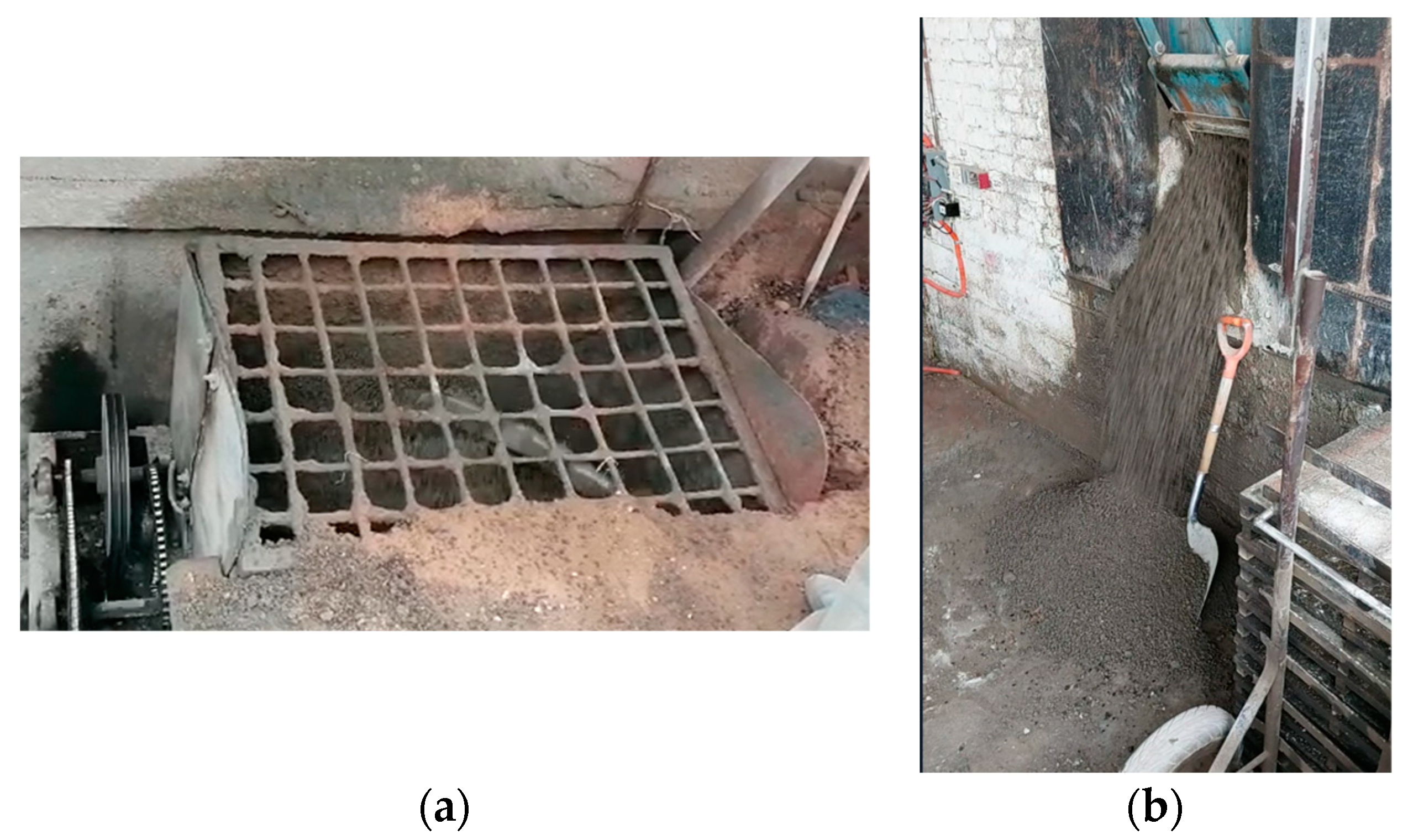
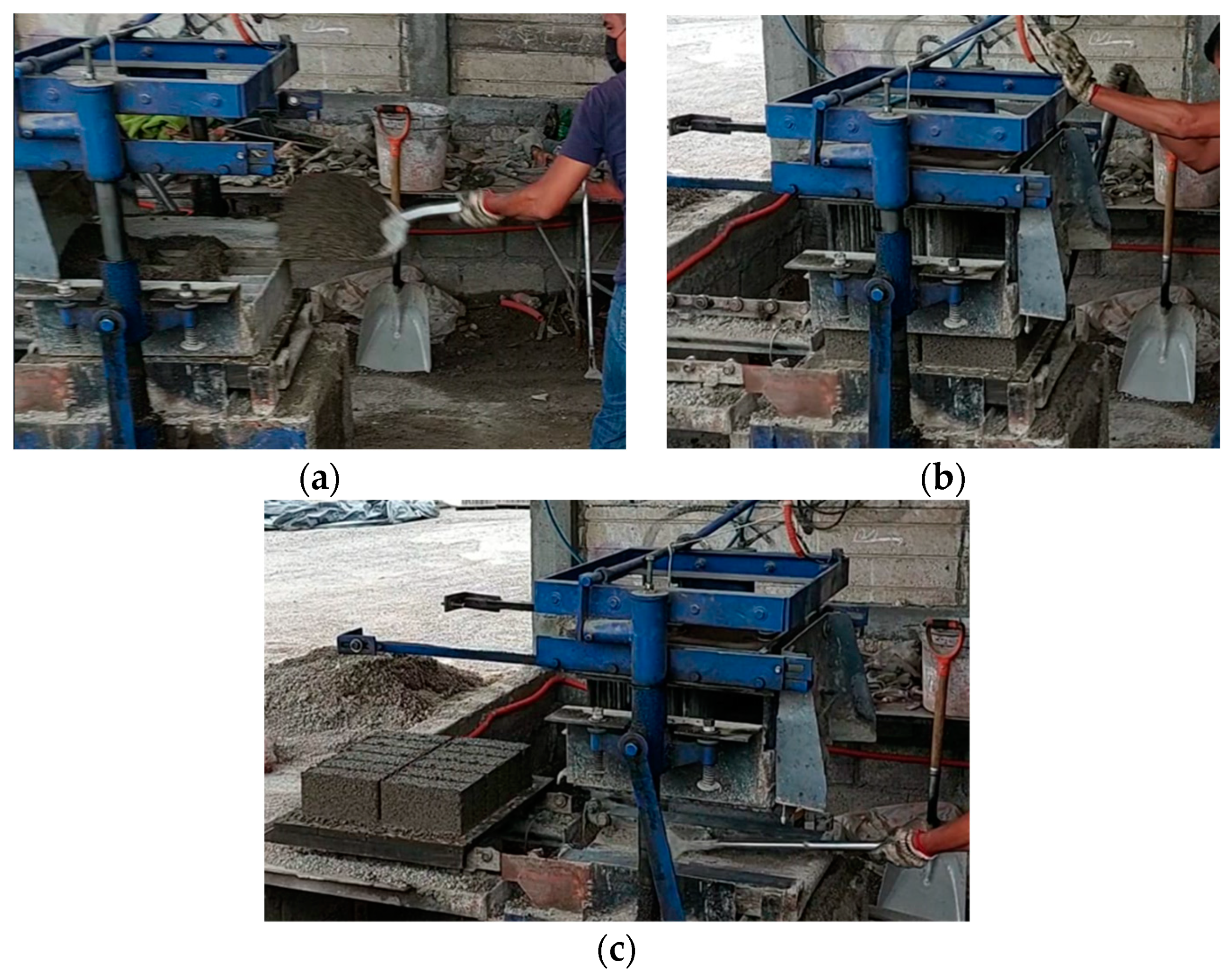

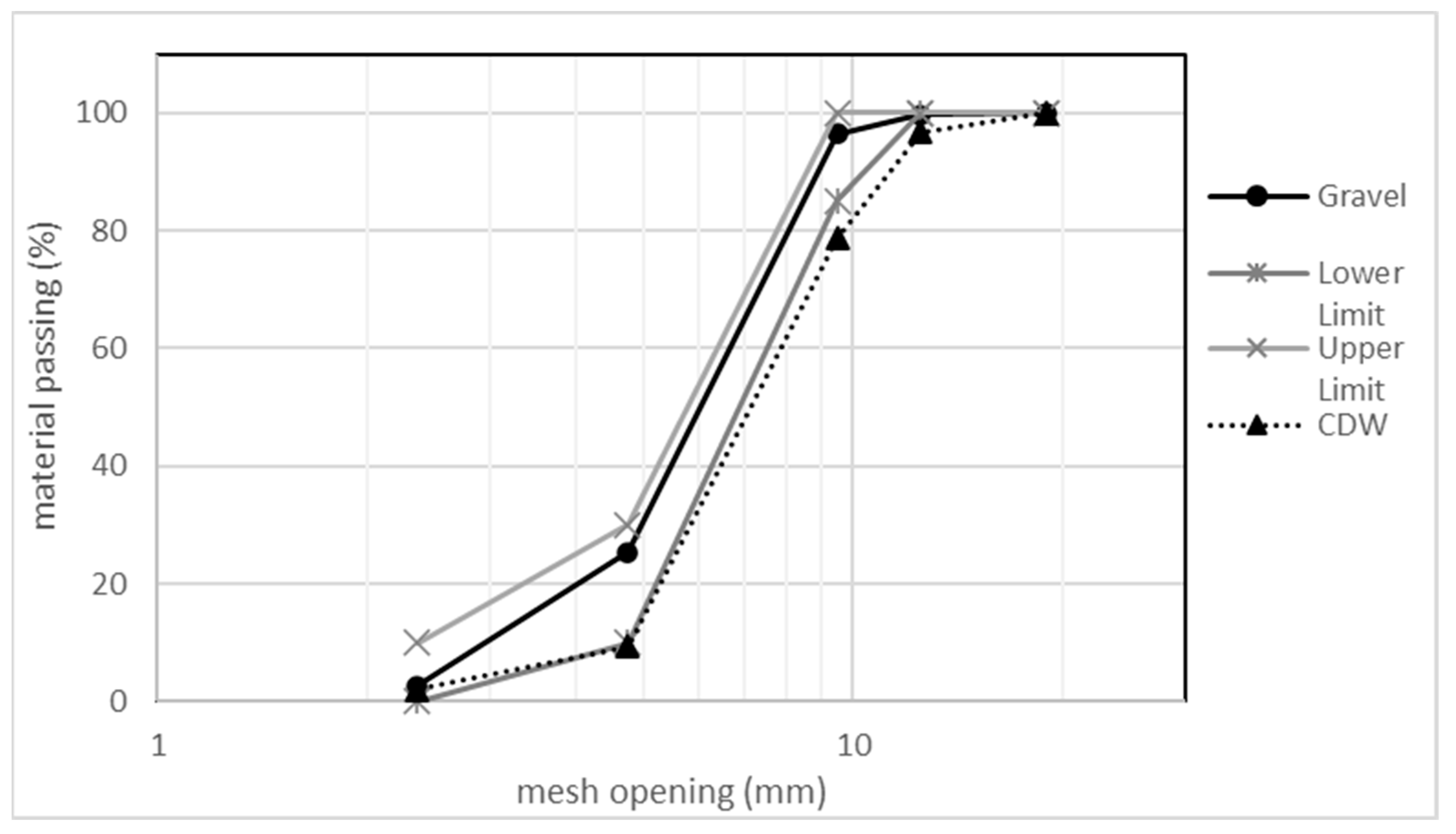
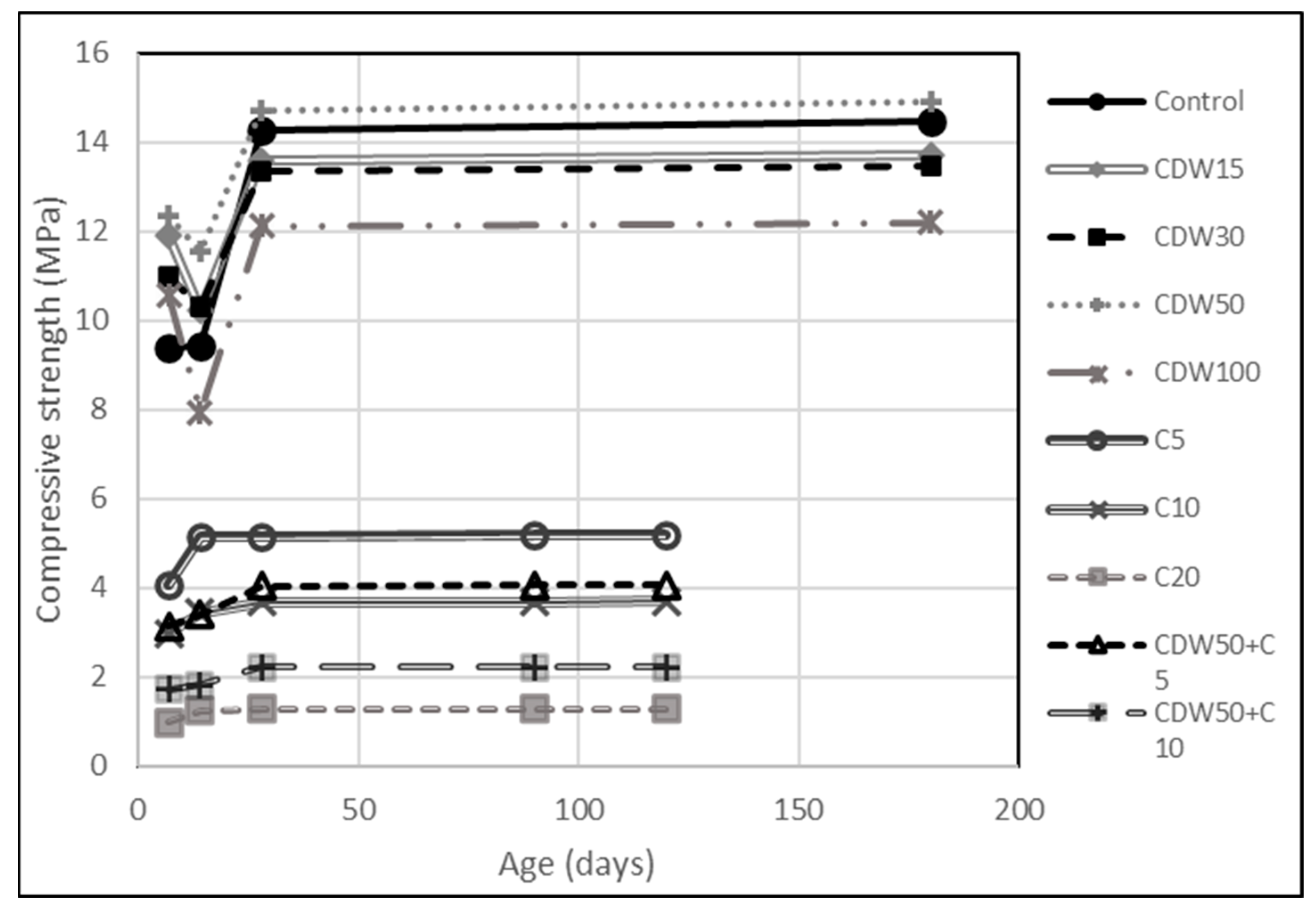
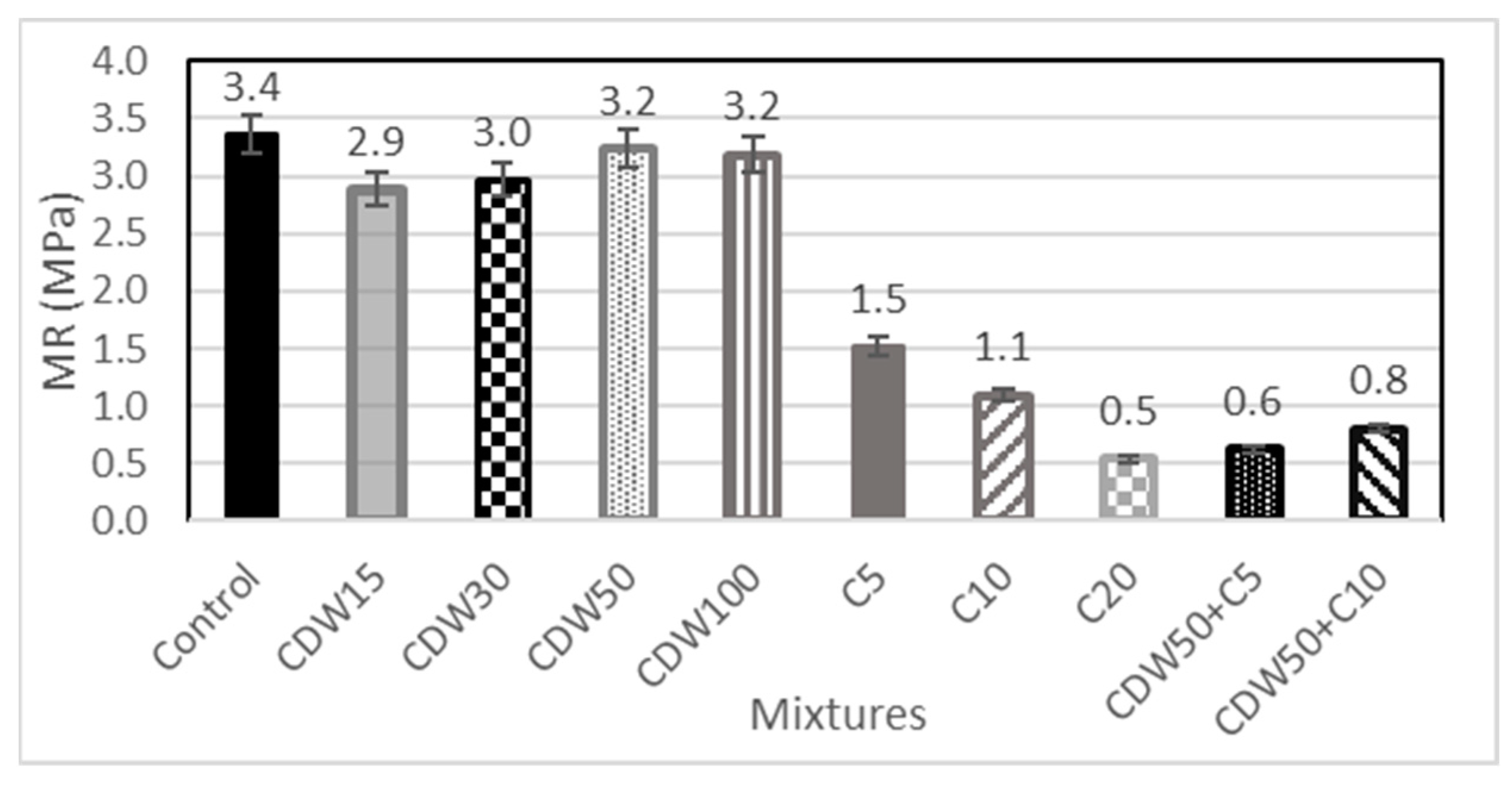

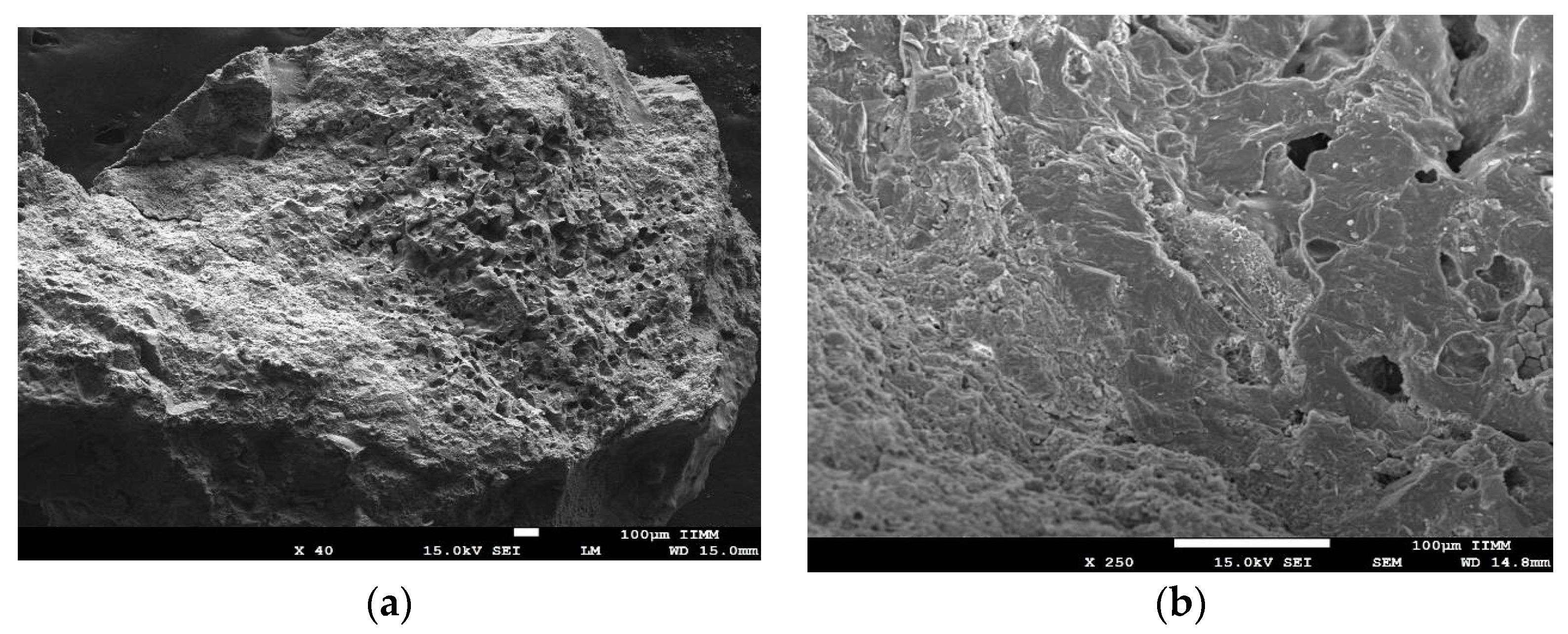

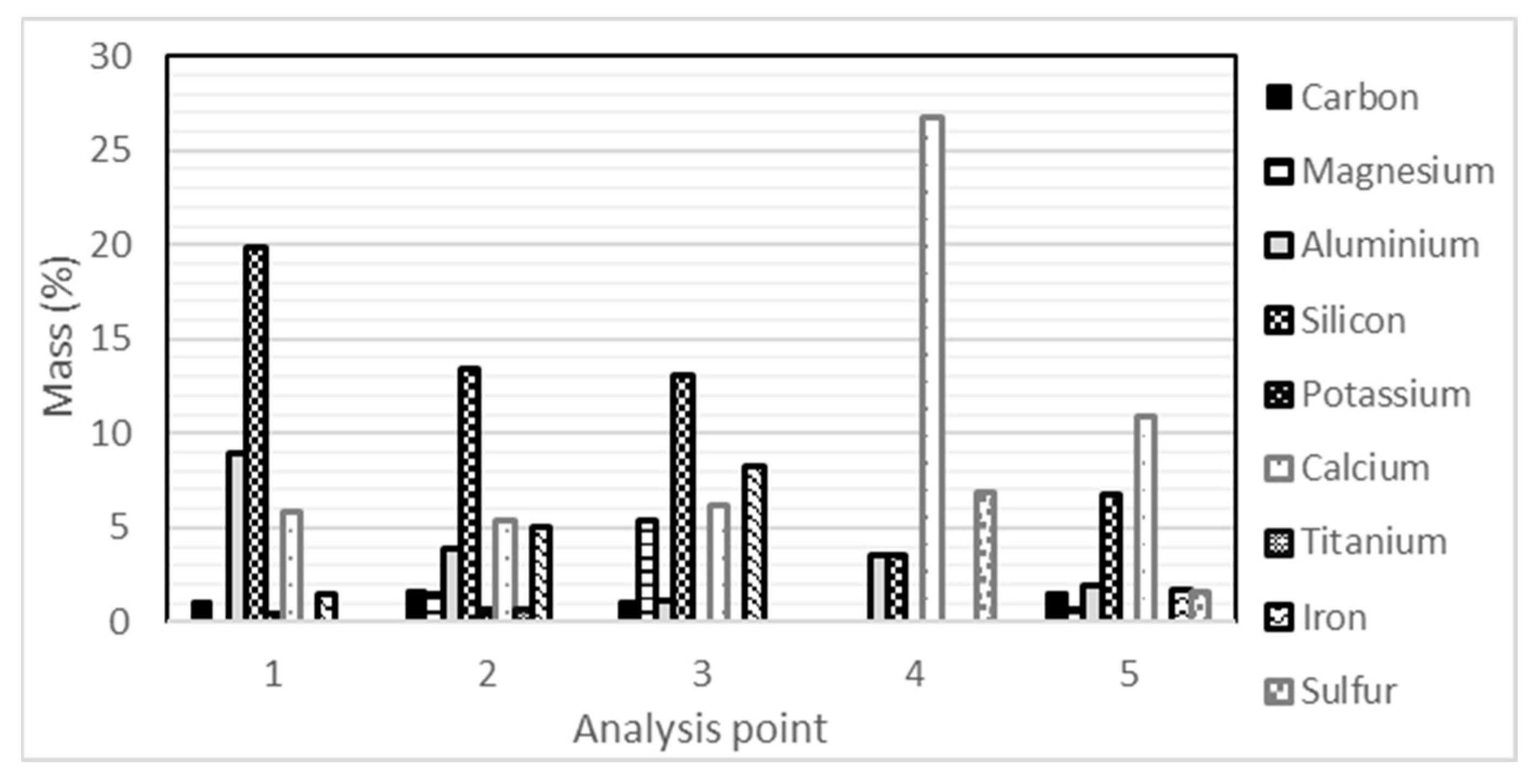

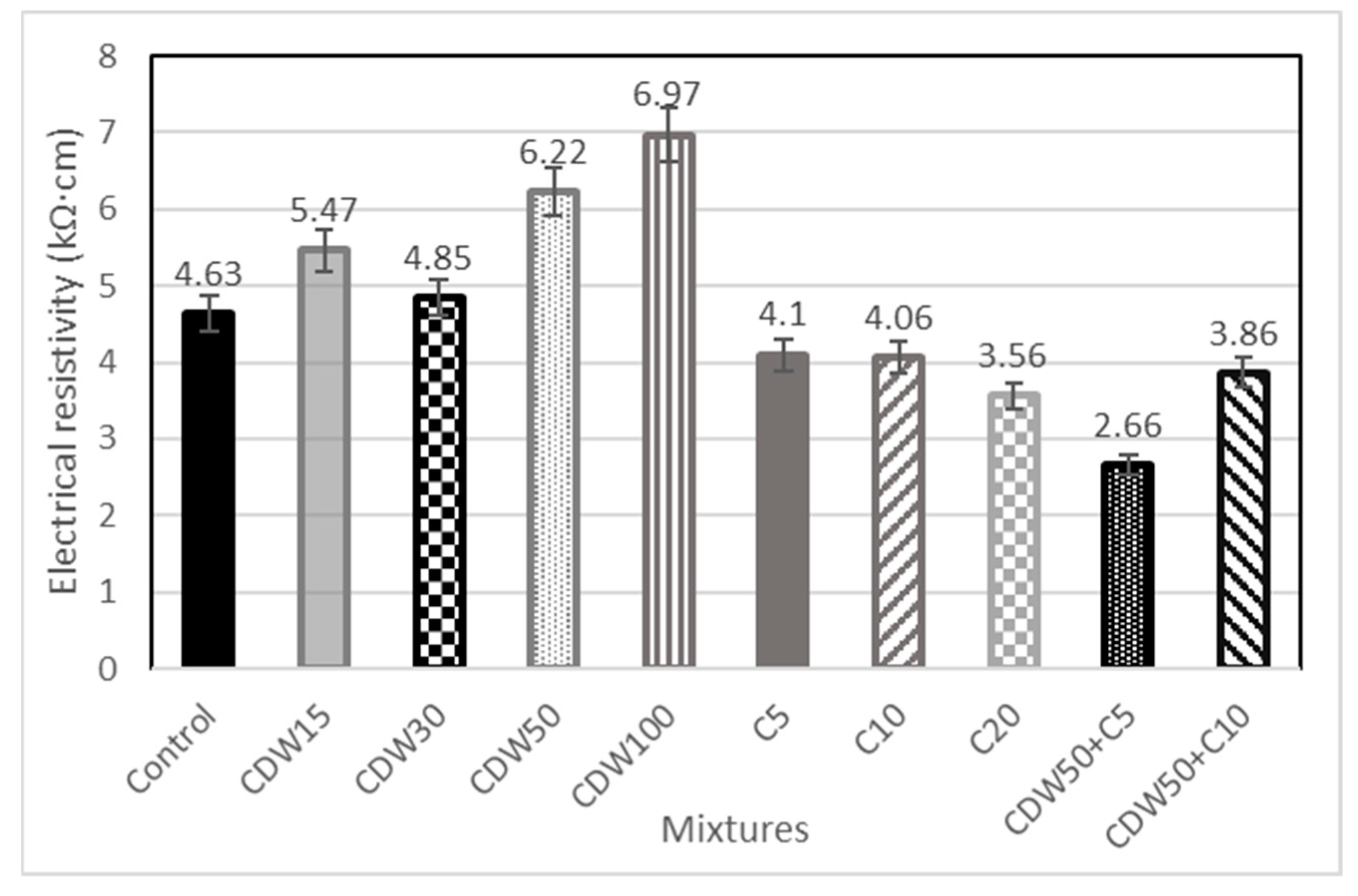
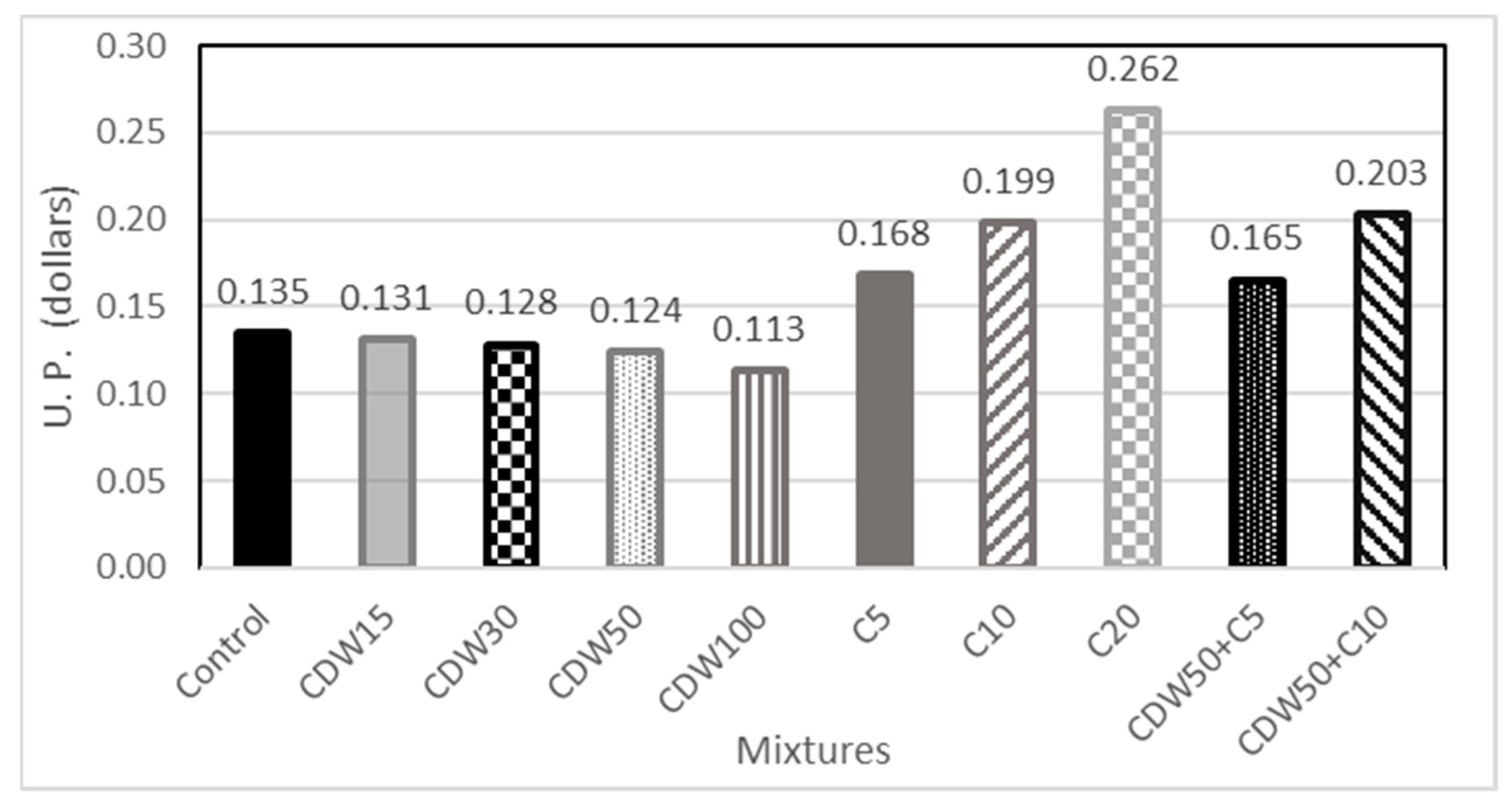

| Mixtures | Nomenclature | Cement (kg) | Gravel (kg) | Silt (Sand) (kg) | Water (kg) | CDW (kg) | Tire Flakes (kg) | Workability (Inches) |
|---|---|---|---|---|---|---|---|---|
| Control | Control | 12 | 90.8 | 75.3 | 11.7 | 0 | 0 | 0 |
| CDW 15% | CDW15 | 12 | 77.18 | 75.3 | 11.7 | 13.62 | 0 | 0 |
| CDW 30% | CDW30 | 12 | 63.56 | 75.3 | 11.7 | 27.24 | 0 | 0 |
| CDW 50% | CDW50 | 12 | 45.4 | 75.3 | 11.7 | 45.4 | 0 | 0 |
| CDW 100% | CDW100 | 12 | 0 | 75.3 | 11.7 | 90.8 | 0 | 0 |
| Tire flakes 5% | C5 | 12 | 90.8 | 71.54 | 11.7 | 0 | 3.77 | 0 |
| Tire flakes 10% | C10 | 12 | 90.8 | 67.77 | 11.7 | 0 | 7.53 | 0 |
| Tire flakes 20% | C20 | 12 | 90.8 | 60.24 | 11.7 | 0 | 15.06 | 0 |
| CDW 50% + tire flakes 5% | CDW50 + C5 | 12 | 40.86 | 75.3 | 11.7 | 45.4 | 4.54 | 0 |
| CDW 50% + tire flakes 10% | CDW50 + C10 | 12 | 36.32 | 75.3 | 11.7 | 45.4 | 9.08 | 0 |
| Test | Standard | Specimen Dimensions |
|---|---|---|
| Compression fc | ASTM C140/C140M-21 [43] | Height = 7 cm; width = 13 cm; length = 24 cm |
| Flex ff | ASTM C78/C78M-22 [44] | Height = 7 cm; width = 13 cm; length = 24 cm |
| Absorption rate | ASTM C566-19 [45] | Height = 7 cm; width = 13 cm; length = 24 cm |
| Modulus of elasticity | ASTM C469/C469M-22 [46] | Cylinders: diameter = 10 cm; height 20 cm |
| Electrical resistivity | ASTM C1876-19 [47] | Cylinders: diameter = 10 cm; height 20 cm |
| Material | Absorption (%) | Density (g/cm3) | MVSS (g/cm3) | MVSV (g/cm3) | Fineness Modulus (%) | Maximum Aggregate Size (Inches) |
|---|---|---|---|---|---|---|
| Silt (sand) | 10.32 | 2.11 | 1.21 | 1.31 | 2.25 | / |
| Gravel | 15.53 | 1.7 | 0.65 | 0.71 | / | 3/8″ |
| CDW | 13.12 | 2.04 | 1.05 | 1.13 | / | 3/8″ |
Disclaimer/Publisher’s Note: The statements, opinions and data contained in all publications are solely those of the individual author(s) and contributor(s) and not of MDPI and/or the editor(s). MDPI and/or the editor(s) disclaim responsibility for any injury to people or property resulting from any ideas, methods, instructions or products referred to in the content. |
© 2023 by the authors. Licensee MDPI, Basel, Switzerland. This article is an open access article distributed under the terms and conditions of the Creative Commons Attribution (CC BY) license (https://creativecommons.org/licenses/by/4.0/).
Share and Cite
Arreola-Sanchez, M.; Martinez-Molina, W.; Chavez-Garcia, H.L.; Navarrete-Seras, M.A.; Borrego-Perez, J.A.; Velazquez-Perez, J.A.; Ruiz-Ruiz, R.; Cervantes-Servin, A.I.; Pelagio-Chávez, A.; Alonso-Guzman, E.M. Physical-Mechanical Behavior of CDW and Tire Flake Integration in Building Block Manufacturing. Sustainability 2023, 15, 15418. https://doi.org/10.3390/su152115418
Arreola-Sanchez M, Martinez-Molina W, Chavez-Garcia HL, Navarrete-Seras MA, Borrego-Perez JA, Velazquez-Perez JA, Ruiz-Ruiz R, Cervantes-Servin AI, Pelagio-Chávez A, Alonso-Guzman EM. Physical-Mechanical Behavior of CDW and Tire Flake Integration in Building Block Manufacturing. Sustainability. 2023; 15(21):15418. https://doi.org/10.3390/su152115418
Chicago/Turabian StyleArreola-Sanchez, Mauricio, Wilfrido Martinez-Molina, Hugo Luis Chavez-Garcia, Marco Antonio Navarrete-Seras, Jorge Alberto Borrego-Perez, Judith Alejandara Velazquez-Perez, Rosalia Ruiz-Ruiz, Adrian Ixcoatl Cervantes-Servin, Adriana Pelagio-Chávez, and Elia Mercedes Alonso-Guzman. 2023. "Physical-Mechanical Behavior of CDW and Tire Flake Integration in Building Block Manufacturing" Sustainability 15, no. 21: 15418. https://doi.org/10.3390/su152115418
APA StyleArreola-Sanchez, M., Martinez-Molina, W., Chavez-Garcia, H. L., Navarrete-Seras, M. A., Borrego-Perez, J. A., Velazquez-Perez, J. A., Ruiz-Ruiz, R., Cervantes-Servin, A. I., Pelagio-Chávez, A., & Alonso-Guzman, E. M. (2023). Physical-Mechanical Behavior of CDW and Tire Flake Integration in Building Block Manufacturing. Sustainability, 15(21), 15418. https://doi.org/10.3390/su152115418







